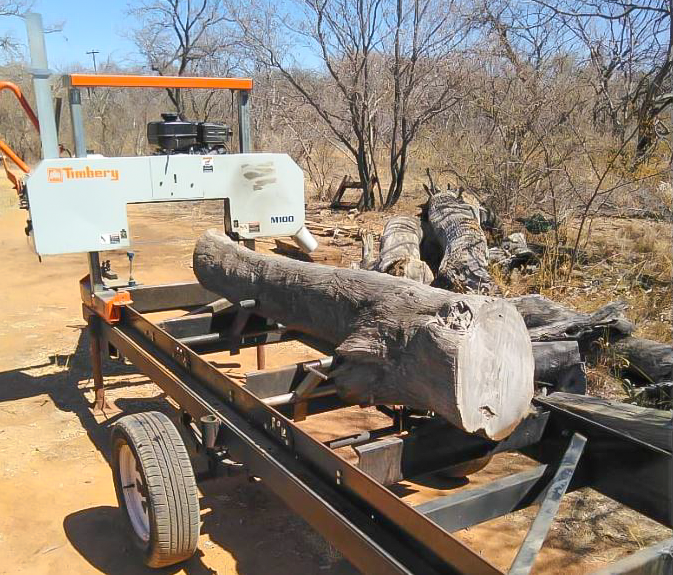A sawmiller from Botswana uses an entry-level Wood-Mizer sawmill to produce high-value custom furniture out of the iron-hard logs from that country.
It was predestined that Robbie Jordaan should be born in Kimberley, the diamond capital of the world.

The grains of a leadwood log after being sliced in two.
His birthplace shaped his lifelong passion for working with hard materials like concrete and timber. His large frame and strength made it easier to bend stubborn materials into the products that he imagined.
Rob tried his hand at a few professions after being schooled in Botswana and South Africa. But a company that made furniture from railway sleepers that his Dad started held Rob’s attention.

Rob Jordaan with his sawmill in the Botswana bush.
Railway sleepers are typically cut from rock-hard timbers to make them resistant to insect attack and damage from the weather.
Rob’s grit and his talent to shape furniture from these diamond-hard timber species was the start of his lifelong passion for timber.

A rustic bench from hardwoods that Rob cut and then built the bench from.
Sawing the sleepers into boards saw Rob trading cross-border with a farmer in the Marico district of South Africa’s North-West Province.
There a water-cooled circular saw split the sleepers into boards that Rob turned into bar counters, heavy-dimensioned rustic furniture, and bespoke pieces for customers.
Cutting diamond
Rob’s dream to cut his timber remained, a heavy slab of concrete that he cut at a construction job making him think again how to cut the diamond-hard logs from Botswana into sawn timber?
Visits to sawmill suppliers in South Africa did not help too. He was given many choices, all of it very expensive given what he wanted to cut. His budget also remained small.

A superb coffee table with heavy wrought-iron base.
A small but tough and very affordable sawmill manufactured by a Wood-Mizer subsidiary caught his eye. He finally had the sawmill to cut and unlock the beauty from the heavy and dense grains of Botswana’s hardwoods.
With sawmill in place and his construction job adding to his pocket, Rob could now produce the sawn timber needed for custom commissions.

A live-edge slab cut by Rob makes a dining room table fit for a king.
The Wood-Mizer sawmill did not disappoint either, the 9 HP petrol engine cutting logs with
400 – 500 mm diameters. The largest leadwood Rob has cut measured 600 mm in diameter and 2,9 m in length.
“The trick to cut them is to cut very slowly and with a lot of water to keep the blade lubricated,” Rob says.
Finding the logs for sawn timber is a tough job.
Farmers and landowners contact Rob to remove heavy logs that have stood rooted for decades. Some have been set on fire to remove them.
His love for nature stops him from taking down trees that are alive. This makes his job to cut the heavy and dry timber into boards even more difficult.
“I’m using an entry-level Wood-Mizer product to do the job that much bigger machines are made to do.
“Despite its size, and regular use over several years, the Wood-Mizer mill stands up to the job, regular maintenance and using the right blades from Wood-Mizer ensuring that it boxes far above its weight,” Rob says.
Another little giant
The recent introduction of Wood-Mizer’s LX25 and LX50 allows for the same and bigger performance than Rob’s current mill.
With a 660 mm log diameter, 558 mm wide cut and 3,7 m log length, the Wood-Mizer LX25 packs a heavy punch with a large-in-class cutting capacity.
It offers a 9,5 HP petrol engine for sawmillers that need more performance.
Several additional features like an adjustable blade guide arm, easy blade engage, auto-locking sawhead, quick-set log clamps, 4 quick-set side supports, adds further value to the LX25.
This, together with a very affordable price tag, makes the Wood-Mizer’s LX25 a very attractive option for sawmillers with dreams like Rob’s.

Wood-Mizer’s LX25 is a very affordable sawmilling solution for sawmillers with dreams like Rob Jordaan’s.
Go to our website and find out more.









